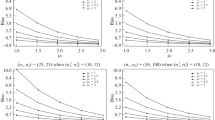Abstract
The interquartile range is a statistical measure well suited to describe the variability of the data at hand, both at the population level and for sample data. The interquartile range is particularly useful when the distribution of the data is asymmetric or irregularly shaped. Here, the use of the interquartile range is investigated when the main aim is to compare the variability of two distributions using two independent random samples, without the need to make any distributional assumptions. Several techniques are compared through numerical studies and real data examples, with a particular attention given to the use of sample quantiles based on the Harrel-Davis estimator or the quantile regression.




Similar content being viewed by others
References
Akinshin A (2022) Trimmed Harrell-Davis quantile estimator based on the highest density interval of the given width. Commun Stat Simul Comput. https://doi.org/10.1080/03610918.2022.2050396
Barrodale I, Roberts F (1974) Solution of an overdetermined system of equations in the L1 norm. Commun ACM 17(6):319–320
Canty A, Ripley B (2021) boot: Bootstrap R (S-Plus) Functions
Choi L (2011) ProfileLikelihood: profile likelihood for a parameter in commonly used statistical models
Choi L, Blume JD, Dupont WD (2015) Elucidating the foundations of statistical inference with \(2 \times 2\) tables. PLoS ONE 10(4):e0121263
Clark F et al (2012) Effectiveness of a lifestyle intervention in promoting the well-being of independently living older people: results of the well elderly 2 randomised controlled trial. J Epidemiol Community Health 66:782–790
Davison AC, Hinkley DV (1997) Bootstrap methods and their application, vol 1. Cambridge University Press, Cambridge
Farcomeni A, Greco L (2016) Robust methods for data reduction. CRC Press, Boca Raton
Feng X, He X, Hu J (2011) Wild bootstrap for quantile regression. Biometrika 98(4):995–999
Fisher RA (1935) The logic of inductive inference. J R Stat Soc 98(1):39–82
Gould W et al (1998) Interquartile and simultaneous-quantile regression. Stata Tech Bull 7(38):14–21
Greco L, Luta G, Krzywinski M, Altman N (2019) Analyzing outliers: robust methods to the rescue. Nat Methods 16(4):275–277
Hahn J (1995) Bootstrapping quantile regression estimators. Econom Theory 11(1):105–121
Harrell FE, Davis C (1982) A new distribution-free quantile estimator. Biometrika 69(3):635–640
He X, Hu F (2002) Markov chain marginal bootstrap. J Am Stat Assoc 97(459):783–795
Hyndman RJ, Fan Y (1996) Sample quantiles in statistical packages. Am Stat 50(4):361–365
Johnson WD, Romer JE (2016) Hypothesis testing of population percentiles via the Wald test with bootstrap variance estimates. Open J Stat 6(1):14
Johnson WD, Beyl RA, Burton JH, Johnson CM, Romer JE, Zhang L (2015) Use of Pearson’s Chi-square for testing equality of percentile profiles across multiple populations. Open J Stat 5(5):412
Koenker RW (2005) Quantile regression. Cambridge University Press, Cambridge
Koenker RW, Bassett G (1982) Tests of linear hypotheses and L1 estimation. Econometrica: J Econ Soc 50(6):1577–1583
Koenker R, D’Orey V (1987) Algorithm AS229: computing regression quantiles. Appl Stat 36:383–393
Koenker R, Hallock KF (2001) Quantile regression. J Econom Perspect 15(4):143–156
Koenker RW, Portnoy S, Ng PT, Zeileis A, Grosjean P, Ripley BD (2018) Package ‘quantreg’. Cran R-project org
Liu X, Song Y, Zhang K (2022) An exact bootstrap-based bandwidth selection rule for kernel quantile estimators. Commun Stat Simul Comput. https://doi.org/10.1080/03610918.2022.2110595
Mair P, Wilcox R (2020) Robust statistical methods in R Using the WRS2 package. Behav Res Methods 52:464–488
Mathisen HC (1943) A method of testing the hypothesis that two samples are from the same population. Ann Math Stat 14(2):188–194
Parzen MI, Wei LJ, Ying Z (1994) A resampling method based on pivotal estimating functions. Biometrika 81(2):341–350
R Core Team (2021) R: a language and environment for statistical computing. R Foundation for Statistical Computing, Vienna, Austria, https://www.R-project.org/
Westenberg J (1947) Mathematics of pollen diagrams. i-ii. In: Proc. Kon. Ned. Akad. Wet, vol 50
Westenberg J (1948) Significance test for median and interquartile range in samples from continuous populations of any form. In: Proceedings for Koninklijke Nederlandse Akademie van Wetenschappen, pp 252–261
Wilcox RR (2022) Introduction to robust estimation and hypothesis testing, 5th edn. Academic Press, New York
Acknowledgements
The authors wish to thank two anonymous reviewers for their helpful comments.
Author information
Authors and Affiliations
Corresponding author
Additional information
Publisher's Note
Springer Nature remains neutral with regard to jurisdictional claims in published maps and institutional affiliations.
Appendix
Appendix
See Tables 5, 6, 7, 8, 9, 10, 11, 12, 13, 14, 15, 16, 17, 18, 19, 20, 21, 22, 23.
Rights and permissions
Springer Nature or its licensor (e.g. a society or other partner) holds exclusive rights to this article under a publishing agreement with the author(s) or other rightsholder(s); author self-archiving of the accepted manuscript version of this article is solely governed by the terms of such publishing agreement and applicable law.
About this article
Cite this article
Greco, L., Luta, G. & Wilcox, R. On testing the equality between interquartile ranges. Comput Stat (2023). https://doi.org/10.1007/s00180-023-01415-8
Received:
Accepted:
Published:
DOI: https://doi.org/10.1007/s00180-023-01415-8




